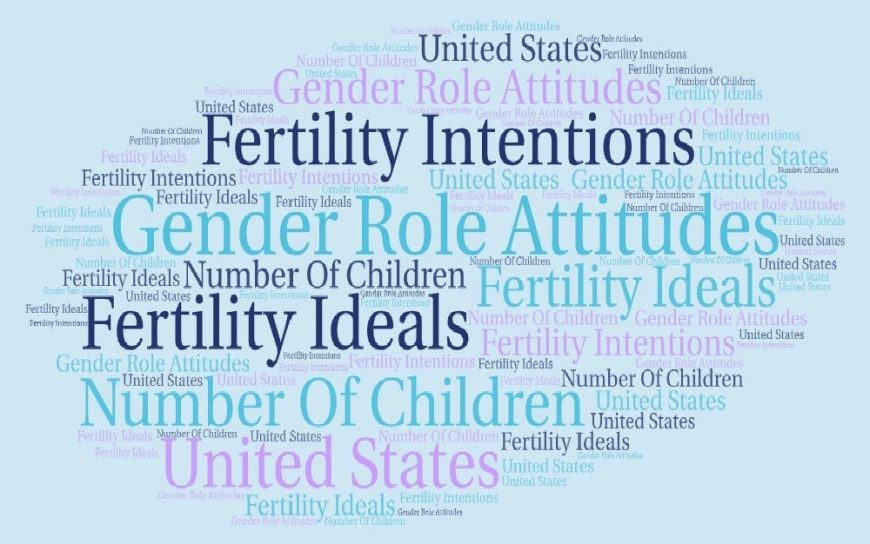Gender Role Attitudes and Fertility Revisited: Evidence from
the United States
Whether gender egalitarianism is associated with higher or lower fertility intentions is debatable. Some studies show that gender egalitarianism is associated with higher fertility intentions; others document the opposite. Moreover, the interrelationship may vary by gender and across countries. Based on longitudinal data from the National Longitudinal Survey of Youth 1979 in the United States, we examine the effects of gender role attitudes with multiple measures of fertility (ideals, intentions and outcomes) and investigate how gender role attitudes are reshaped by the number of children. Our results show that individuals holding more egalitarian attitudes tend to have a smaller ideal family size, desire fewer children and have fewer children. In addition, for both men and women, the arrival of children can shape gender role attitudes towards more traditional ones. Different dimensions of gender attitudes may, however, affect and be affected by fertility to different extents, and the interrelationship can vary across gender. Our study adds more evidence to the debate over the effect of gender role attitudes on fertility, helps to understand distinct findings in the literature, sheds light on the development of gender role attitudes of men and women over time, and highlights the importance of using longitudinal data to examine the effects of gender attitudes on fertility behaviors.
Volume 59, Number 2, 2020
Type: Article, pp. 111-138
Gender Role Attitudes and Fertility Revisited: Evidence from
the United States
Authors: Qianqian Shang and Yongkun Yin
Affiliations: Center for Monetary and Financial Studies, Madrid, Spain (Shang); Center for Monetary and Financial Studies, Madrid, Spain (Yin)
Corresponding author/address: Yongkun Yin, Center for Monetary and Financial Studies, Madrid, Spain; email: yongkun.yin@cemfi.edu.es
Abstract
Whether gender egalitarianism is associated with higher or lower fertility intentions is debatable. Some studies show that gender egalitarianism is associated with higher fertility intentions; others document the opposite. Moreover, the interrelationship may vary by gender and across countries. Based on longitudinal data from the National Longitudinal Survey of Youth 1979 in the United States, we examine the effects of gender role attitudes with multiple measures of fertility (ideals, intentions and outcomes) and investigate how gender role attitudes are reshaped by the number of children. Our results show that individuals holding more egalitarian attitudes tend to have a smaller ideal family size, desire fewer children and have fewer children. In addition, for both men and women, the arrival of children can shape gender role attitudes towards more traditional ones. Different dimensions of gender attitudes may, however, affect and be affected by fertility to different extents, and the interrelationship can vary across gender. Our study adds more evidence to the debate over the effect of gender role attitudes on fertility, helps to understand distinct findings in the literature, sheds light on the development of gender role attitudes of men and women over time, and highlights the importance of using longitudinal data to examine the effects of gender attitudes on fertility behaviors.
Keywords
Gender role attitudes, fertility ideals, fertility intentions, number of children, United States
© 2020 Sociological Demography Press
MLA
Shang, Qianqian and Yongkun Yin. “Gender Role Attitudes and Fertility Revisited: Evidence from the United States.” Population Review, vol. 59 no. 2, 2020. Project MUSE muse.jhu.edu/article/763413.
APA
Shang, Q., & Yin, Y. (2020). Gender Role Attitudes and Fertility Revisited: Evidence from the United States. Population Review 59(2), https://www.muse.jhu.edu/article/763413.
Chicago
Shang, Qianqian, and Yongkun Yin. “Gender Role Attitudes and Fertility Revisited: Evidence from the United States.” Population Review 59, no. 2 (2020) muse.jhu.edu/article/763413.
Endnote
TY – JOUR T1 – Gender Role Attitudes and Fertility Revisited: Evidence from the United States A1 – Shang, Qianqian A1 – Yin, Yongkun JF – Population Review VL – 59 IS – 2 PY – 2020 PB – Sociological Demography Press SN – 1549-0955 UR – https://muse.jhu.edu/article/763413 N1 – Volume 59, Number 2, 2020 ER –
Always review your references for accuracy and make any necessary corrections before using. Pay special attention to personal names, capitalization, and dates. Consult your library for more information on citing sources.




